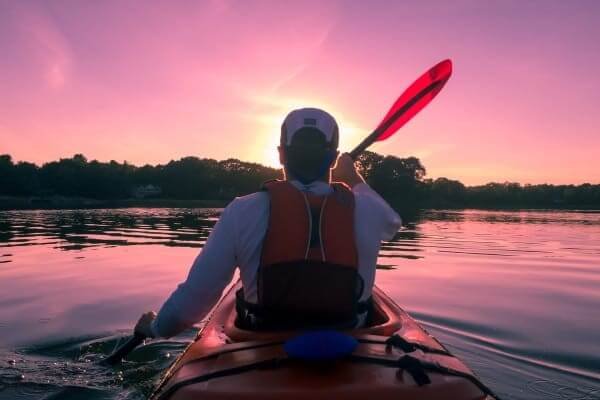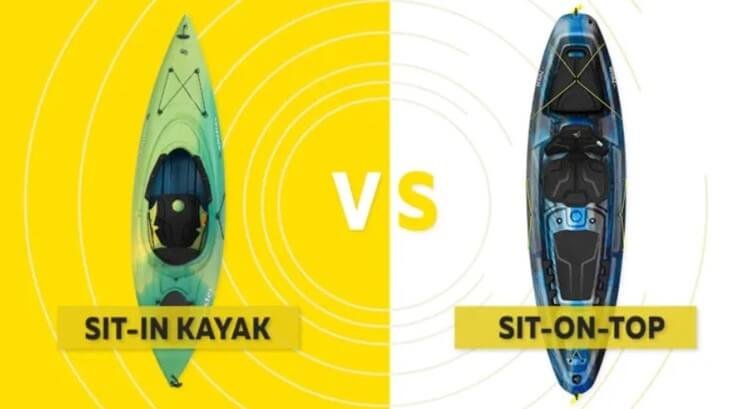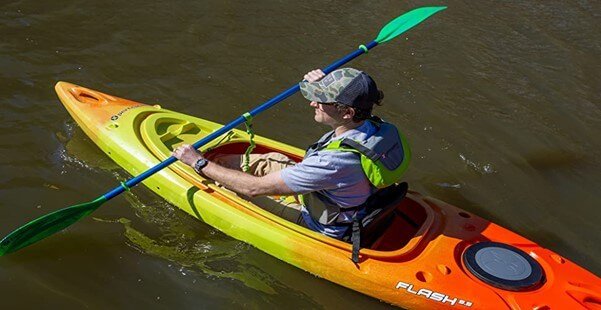One of the most common questions you hear in the kayak industry is “Should I get a sit-on or a sit-in kayak”? This is the first decision you should make before buying a kayak. The truth is that the decision to get a sit-on-top or sit-inside kayak will mostly be based on personal preference, although there are a few other factors to consider.
So, in “Sit On VS Sit in Kayaks” which one would be better for you, the sit-in or the sit-on-top? Sit-in kayaks are better for cold or rough water and when you don’t want to get wet. A sit-on-top kayak is better for beginners, summer, and fun. A sit-in kayak is optimal for long-distance travel, surfing, and paddling. While sit-on kayaks are better for learning, cooling off, and getting in and out of your kayak more often.
If you’re buying your first kayak, you’ll need to consider the differences between each of these kayak options. This article will give you a clear picture of which style of kayak best suits your needs as for the type and according to your level of kayaking.
Before talking about the difference between sit-on-top and sit-in-kayaks, we should have a little description of these two terms: sit-on-top and sit-in-kayak.
Sit On VS Sit in Kayaks:
Sit-in kayak
Sit-insides, or sis for short, are more traditional-looking kayaks like the Lifetime Payette Kayak. These have an open cockpit where the paddler climbs up and actually sits inside the hull of the kayak with their feet below deck. Depending on the design of the kayak, this style allows you to move your knees away from the inside walls of the hull to help with a stronger and more efficient paddle stroke.
Many sit-ins are also able to take the skirt off. Skirts are designed to close or cover the opening of the cockpit in sit-inside kayaks. The paddler wears a skirt around his waist. There is a piece of cloth with a tightening mechanism that allows the paddler to sit in the kayak and stretch the skirt material around the cockpit rim, locking the inside of the rudder. This is great for paddling in cold weather. This will prevent water from splashing into the kayak and onto the paddler’s feet. In general, you will not be too wet in a sit-in compared to a in a sit-on-top, except if you flip your kayak over.
Flipping a kayak over is much more complicated than you might think. Most of the people are anxious about SIS because of the “flipping factor” In truth, flipping your kayak really isn’t easy. Most recreational kayaks like Lifetime Kayak are built to be stationary. Whether sit-on-top or sit-in, the flipping factor will have more to do with kayak design and hull shape than with sit-on-top or sit-in. And don’t worry, if you turn it over, you won’t get stuck. The paddler can immediately exit the kayak and come to the surface of the water.
Sit-on-top kayak
Sit-on-tops, or SOTs for short, are rapidly growing in popularity. Basically, this style allows and helps the paddler to sit on top of the kayak deck. There is no “inside” that can be settled by the paddler. The only access, if any, to the inside of the kayak will be through the storage hatch opening. Everything from the footwells to the seat backs will be mounted on the actual deck of the kayak. It is very hard to stay dry paddling a SOT. With each wave, the paddler becomes increasingly wet. There is no cockpit or deck area to prevent water from splashing onto the paddler’s body. Because of this, SOTs are extremely popular in warm climates.
Another reason these kayaks are great for hot weather is that it’s easy to slip into the water and climb back into the kayak for a quick swim. Unlike sit-down kayaks, you can re-enter your SOT from the water. It might not be easy, but you can pull yourself back onto the deck of your SOT and reposition yourself for paddling. For a slightly dry ride, you can get scooper plugs. Scooper plugs will cover the self-baling drain hole found on SOT kayaks.
The purpose of the scooper hole is to allow splashing water to back out onto the deck and not to settle under the paddler. Blocking these holes won’t cause small splashes of water from underwater through the holes, but it will prevent any water from seeping back out onto the deck.
Comparing Performance Between a Sit-on-Top and a Sit-in Kayak
There’s no doubt that sit-in kayaks outperform sit-on-tops. There are several reasons for this:
- Your center of gravity is low, which allows the kayak to be narrower and still maintain stability. A narrower kayak moves through the water more efficiently than a wider sit-on-top.
- Sit-ins allow for a more physical connection with the kayak. You are not only sitting down, your thighs, knees and feet are also engaged.
- Sit-on-tops are, essentially, made of heavy moulded plastic. On the other hand, sit-ins can also be made of high-end materials that are lightweight and fast.
Comparing comfort
No arguing here—sit-on-tops are more comfortable! You are not confined inside the kayak, so you have more freedom and foot movement. You can also stand up for a change, which can make a big difference in a long day of paddling.
Sit-on-tops seats can be, “downright luxurious.” Many sit-on-tops offer height-adjustable seats, giving you even more seating options.
Stability of Sit-on-Tops vs. Sit-in Kayak
- Sit-on-top kayaks are designed for stability across their width and are therefore great for anglers and others who value stability over performance.
- Sit-in kayaks have something called edge stability, which means you can roll them over their edge, and they’ll stay there. This is important for those who value performance paddling over stability.
That said, the more affordable recreational sit-in kayaks are also designed for stability. It would be hard to flip one of them over even if you tried (up to a certain point. Of course)!
Explore different features
The value of the characteristics of sit-on-tops versus sit-ins is very subjective. Deciding, which is the most important to you, along with our first point above, what type of paddling do you want to do?
Sit-in kayaks offer great features for day trips and multi-day trips, like covered hatches with storage space for gear. Bulkheads separate compartments, which helps keep water (mostly) out.
The sit-on-top kayak has great features for fishing, including an open deck with tons of ways to customize it to your liking.

So, which is better: sit-in or sit-on kayak?
The truth is that it depends on the situation, your level of experience, and how and where you plan to kayak.
If you’re an intermediate or advanced kayaker and are likely to be in colder waters, a sit-in kayak is a better option for you. However, if you’re a beginner and aren’t completely comfortable with the idea of paddling a kayak, a sit-on-top may be better for you.
The best choice of kayak really depends on what kind of experience you are looking for during your kayaking excursion. But here are some alternative examples based on general kayaking needs.
Sit-on-top kayaks are better for:
- Summer fun
- Hot weather
- Learn
- Children
- Being rough with your kayak (rotomolded sit-on-top kayaks can take more abuse)
- If you’re afraid of getting stuck in the cockpit when you turn over
- And fishing!
Sit-inside kayaks are better for:
- Cold weather and water
- Long-distance travel
- Ocean tour
- Surf kayaking
- River kayaking; white water and long-distance river both flow
- Race
- Stay dry
Additional Resources
If you are looking for more tutorials, walkthroughs and troubleshooting about camping and enjoying the outdoors, here are some additional posts to check out:
Conclusion
Getting around a kayak isn’t easy! But sit-ins are more lightweight, making them easier for one person to carry. A few sit-on-tops require two people to be carried if it doesn’t have a stern wheel, or if you’re not using a vehicle.
We hope this helps you narrow down your choices about which kayak you should choose for yourself. To help you decide, you can read my articles on “6 Best Rated Sit in Kayaks for Unforgettable Water Adventures” and also “5 Best Rated Sit on Kayaks for Your Ultimate Kayaking Experience”, but for now, Be Safe and Happy Paddling!



